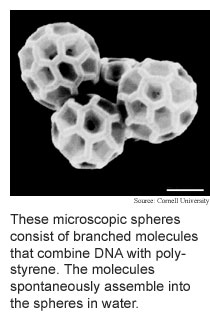
Week
of August 29, 2005
DNA
buckyballs
Drug delivery -- the ability to target drugs to specific parts
of the body -- is a major focus of nanotechnology research. The goal is
to increase the effectiveness and decrease the toxicity of drugs used
to treat diseases like cancer. One approach is to create nanoscale containers
that carry minuscule amounts of substances.
 Researchers
from Cornell University have created
branched molecules that combine DNA, which is attracted to water, and
polystyrene, which is repelled by water. They found that in water the
molecules assemble into buckyballs
-- hollow spheres made up of hexagons and pentagons. The spheres measure
400 nanometers in diameter.
Researchers
from Cornell University have created
branched molecules that combine DNA, which is attracted to water, and
polystyrene, which is repelled by water. They found that in water the
molecules assemble into buckyballs
-- hollow spheres made up of hexagons and pentagons. The spheres measure
400 nanometers in diameter.
In addition to delivering drugs, the DNA buckyballs could be used
as nanoscale test tubes to study minute amounts of substances.
(Self-Assembly of Nanobuckyballs from Dendrimer-like-DNA-Polystyrene
Amphiphiles, American Chemical Society 2005 annual meeting, Washington
DC, August 28, 2005)
Using light to measure force
Micromechanical sensors that measure physical forces like acceleration
usually require that electronic circuits read what microscopic mechanical
devices are doing. Researchers from Rensselaer Polytechnic Institute and
Translume Inc. have made a displacement
sensor that uses light rather than electricity to keep tabs on microscopic
movements.
The prototype sensor is made from a single piece of glass and
can detect movements as small as 50 nanometers, which is more than a thousand
times smaller than the width of a human hair.
Sensors that transmit their signals using light could be used
in environments that usually damage electronics, including space, where
high levels of radiation can interfere with readings and degrade electronic
equipment.
(Integrating Optics and Micro-Mechanics in a Single Substrate:
a Step toward Monolithic Integration in Diffuse Silica, Optics Express,
August 22, 2005)
Observing neurons in their natural habitat
Researchers from Stanford University have produced a very small
version of the endoscope, a common medical device used for probing inside
the body. The handheld device makes it possible to see individual nerve
cells at work inside living brains.
The portable
microendoscope produces clear images at the cellular level using two-photon
fluorescence, a technique normally used by scientists to study the molecular
makeup of materials.
The device can be used to study how diseases like Alzheimer's
affect nerve cells and how the actions of individual nerve cells contribute
to an animal's behavior.
(In Vivo Brain Imaging Using a Portable 3.9-Gram Two-Photon Fluorescence
Microendoscope, Optics Letters, September 1, 2005)
Small-world thresholds by the numbers
Not only is it a small world, but many small worlds. In recent
years scientists have figured out much of the mathematics underpinning
network phenomena like six degrees of separation. All manner of networks,
from the Internet to social networks to cellular interactions, exhibit
small world behavior, meaning that any one node can reach any other node
through a relatively small number of others.
Researchers from the Catholic University of Leuven in Belgium,
Kings College London in England, the Institute for Scientific Interchange
in Italy, and the University of Hasselt in Belgium have put together a
network model that shows
critical thresholds in these networks. A critical network threshold is
a level of connectivity that causes a network's behavior to change abruptly,
like when a disease becomes an epidemic or a power grid is overloaded
and shuts down. The key to finding the critical thresholds is examining
the strength of the connections to big hubs relative to the connections
among smaller nodes.
The model could be used to study and better control natural network
phenomena like diseases and artificial networks like the Internet and
power grids.
(Trading Interactions for Topology in Scale-Free Networks, slated
for publication in Physical Review Letters)
Bits and pieces
An image processing technique sorts
out images from a set of tumbling, spinning, shaking cameras in real-time;
a light-sensitive surface changes
at the molecular scale to allow move droplets uphill; a hologram
replaces several components of liquid crystal displays.
RSS Feeds: News Blog Books New: TRN's Internet Services TRN's Jobs Center News: Research News Roundup Research Watch blog Features: View from the High Ground Q&A How It Works Buy an ad link |
|
| Advertisements: |
|
Ad links: Clear History
Buy an ad link
|
TRN
Newswire and Headline Feeds for Web sites
|